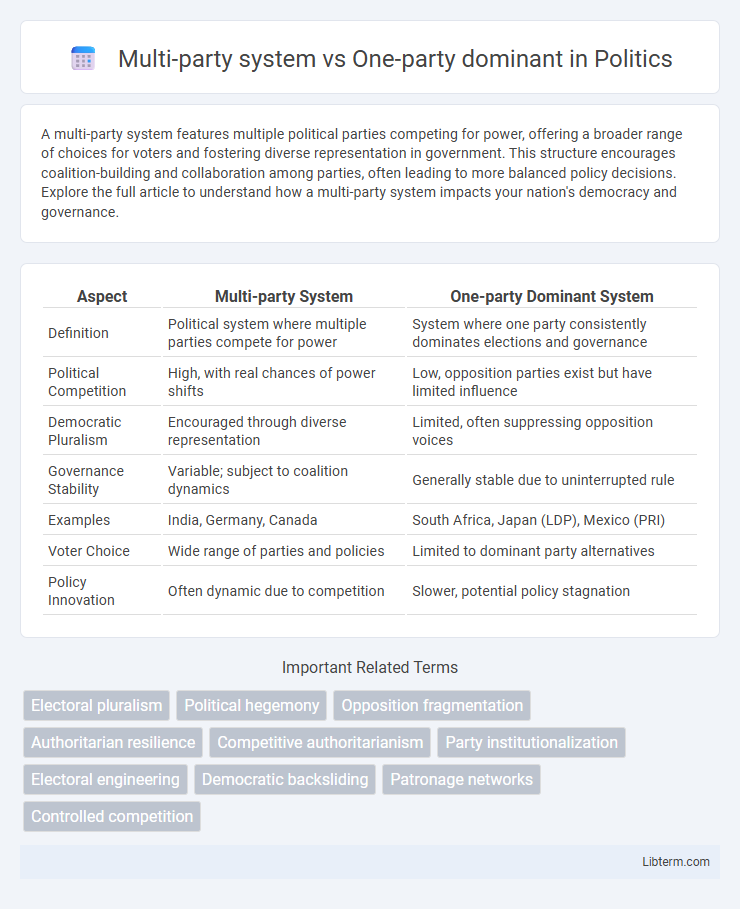A multi-party system features multiple political parties competing for power, offering a broader range of choices for voters and fostering diverse representation in government. This structure encourages coalition-building and collaboration among parties, often leading to more balanced policy decisions. Explore the full article to understand how a multi-party system impacts your nation's democracy and governance.
Table of Comparison
| Aspect | Multi-party System | One-party Dominant System |
|---|---|---|
| Definition | Political system where multiple parties compete for power | System where one party consistently dominates elections and governance |
| Political Competition | High, with real chances of power shifts | Low, opposition parties exist but have limited influence |
| Democratic Pluralism | Encouraged through diverse representation | Limited, often suppressing opposition voices |
| Governance Stability | Variable; subject to coalition dynamics | Generally stable due to uninterrupted rule |
| Examples | India, Germany, Canada | South Africa, Japan (LDP), Mexico (PRI) |
| Voter Choice | Wide range of parties and policies | Limited to dominant party alternatives |
| Policy Innovation | Often dynamic due to competition | Slower, potential policy stagnation |
Introduction to Political Party Systems
Multi-party systems feature multiple political parties competing for power, promoting diverse representation and coalition governance. One-party dominant systems allow a single party to maintain control over extended periods, often limiting political competition and opposition influence. Both systems shape political stability, policy-making, and voter engagement in distinct ways.
Defining Multi-Party Systems
Multi-party systems are characterized by the presence of multiple political parties competing for power, allowing diverse representation and fostering democratic pluralism. In contrast, one-party dominant systems feature a single party that consistently controls government authority while other parties may exist but have limited influence. Multi-party systems enhance political competition and voter choice, essential for accountability and policy innovation in democratic governance.
Understanding One-Party Dominant Systems
One-party dominant systems feature a single political party maintaining power over extended periods, despite the presence of opposition parties, often through institutional advantages and control over state resources. These systems limit genuine political competition, as opposition parties typically lack significant influence or opportunities to challenge the ruling party effectively. Understanding one-party dominance involves analyzing mechanisms like electoral manipulation, patronage networks, and media control that sustain the party's prolonged rule.
Key Differences Between Multi-Party and One-Party Dominant Systems
Multi-party systems feature multiple political parties competing for power, which promotes diverse representation and policy debate, while one-party dominant systems allow a single party to maintain control despite the presence of opposition parties, often leading to limited political competition. In multi-party systems, electoral outcomes tend to be more unpredictable and coalition governments are common, whereas one-party dominant systems usually result in prolonged rule by a single party with minimal power shifts. Voter choice and governance accountability are typically higher in multi-party systems compared to the constrained alternatives in one-party dominant frameworks.
Advantages of Multi-Party Systems
Multi-party systems enhance political representation by allowing diverse views and interests to be included in the legislative process, fostering democratic inclusivity and citizen engagement. They encourage competition among parties, which can lead to more responsive governance and better policy outcomes through negotiation and coalition-building. Electoral systems like proportional representation often support multi-party systems, promoting political pluralism and reducing the risk of authoritarian rule associated with one-party dominant regimes.
Advantages of One-Party Dominant Systems
One-party dominant systems offer political stability by minimizing fragmentation and ensuring consistent policy implementation. They streamline decision-making processes and reduce electoral uncertainty, which can attract long-term investments and foster economic growth. This system also limits political conflict, enabling more efficient governance and focused national development strategies.
Disadvantages of Multi-Party Systems
Multi-party systems often lead to fragmented legislatures, making it difficult to form stable governments and resulting in frequent coalition collapses. The multiplicity of political parties can cause policy gridlock and inefficiency, hindering decisive governance. Voter confusion and diluted accountability are common due to the overwhelming number of party choices and shifting alliances.
Disadvantages of One-Party Dominant Systems
One-party dominant systems often result in reduced political competition, limiting voter choice and undermining democratic principles. The lack of genuine opposition can impede accountability, allowing corruption and authoritarianism to flourish. This concentration of power may also stifle policy innovation, as alternative perspectives and dissenting voices are marginalized.
Real-World Examples and Case Studies
India exemplifies a multi-party system where diverse political parties like the BJP, Congress, and regional parties compete in elections, ensuring pluralism and coalition governments. South Africa represents a one-party dominant system with the African National Congress (ANC) maintaining overwhelming control since the end of apartheid, limiting effective political competition. Case studies from Brazil highlight challenges in multi-party governance, such as coalition instability, while Malaysia's Barisan Nasional dominance illustrates mechanisms sustaining long-term single-party control despite formal multi-party elections.
Conclusion and Future Implications
The multi-party system promotes political pluralism and citizen representation, fostering competitive elections and policy innovation. One-party dominant systems often limit democratic choice, risking authoritarianism and reduced accountability. Future political stability depends on balancing effective governance with inclusive political participation across diverse societies.
Multi-party system Infographic

 libterm.com
libterm.com